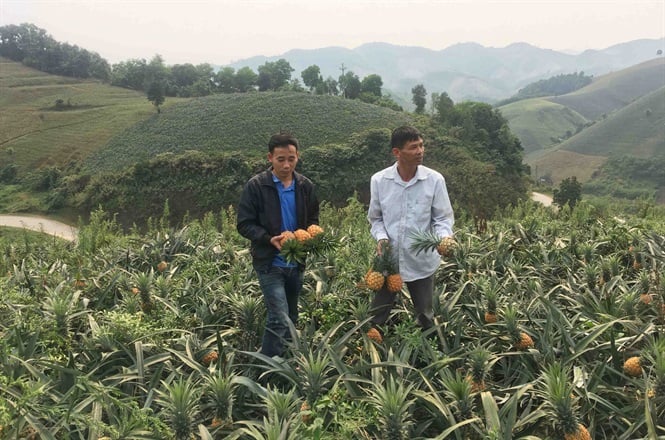November 25, 2025 | 04:50 GMT +7
November 25, 2025 | 04:50 GMT +7
Hotline: 0913.378.918
November 25, 2025 | 04:50 GMT +7
Hotline: 0913.378.918

Lao Cai has up to 1,600 hectares of pineapples with an output of about 40,000 tons. Photo: Ke Toai.
On April 1, 2021, the Lao Cai People's Committee approved a "Project on developing the agricultural and forestry processing network in the province for the period 2021 - 2025".
The project aims to focus on investing and developing key products, associated with branding to promote and introduce them to the market.
Accordingly, 12 key products include 7 of agriculture (tea, vegetables, fruits, rice, medicinal plants, livestock, and aquatic products) and 5 of forestry (furniture, cinnamon, bamboo shoot, truffle oil, and white antler resin).
Speaking at a forum to promote the connection for production and consumption of agricultural products and vegetables in the North (the 16th session of the Agricultural Product Connection Forum 970) held on December 18, Mr. Vuong Tien Sy, Head of Lao Cai Sub-Department of Agriculture, Forestry and Fishery Quality Management said that two of the province's strong agricultural products, tea, and bananas, have been consumed abroad. In which, bananas are officially exported to China while tea is to the Middle East and Europe.
In the coming time, Lao Cai will continue to invest, produce, process and create regional linkage chains, especially for agricultural products. The province is expected to apply many modern farming processes such as those in organic agriculture, setting up planting area codes, and promoting digital and science and technology transformation.
As the province has many distinct climate sub-regions, it has potential for development, especially cold-water fish with an output of about 700 tons.
However, Lao Cai is now facing a pineapple issue with about 1,600 hectares of cultivation and over 40,000 tons of output. While this product has not been officially exported to China, processing factories currently only consume one-third of the total output. The province thus is having to distribute through small retail channels in the country.
"The province is looking forward to connecting with neighboring localities and China, especially for consuming products manufactured following advanced processes, ensuring quality," said Mr. Sy.
A Conference was held recently on the implementation of the Provincial Standing Party Committee’s Resolution No. 10-NQ-TU dated August 26, 2021, on the strategy of agricultural commodity development in Lao Cai to 2030, with a vision to 2050. Speaking at the conference, the Chairman of the provincial People's Committee, Mr. Trinh Xuan Truong emphasized one more task of promoting production associated with processing, gradually shifting to commodity agricultural production along with restructuring into highly efficient crop varieties.
In the short time by 2025, Lao Cai will develop agricultural, forestry, and fishery processing facilities, build 4 processing factories installed with modern machinery and equipment, apply high and advanced technology in processing and preserving agricultural and forestry products. After 2025, localities will focus on upgrading and developing more modern facilities to increase processing capacity especially for a number of key commodities such as medicinal herbs, tea, cinnamon, cattle, and poultry meat...
As a gateway connecting China with the ASEAN region, the amount of agricultural products passing through Lao Cai is very large. Therefore, the province wants the Government, the Ministry of Agriculture and Rural Development (MARD), and related ministries, departments, and agencies to study logistic constructions, exhibitions, and display zones for agricultural products. Lao Cai has set aside more than 300 hectares of land to prepare for this plan.
Areas selected for implementing the plan are located in advantaged localities near Noi Bai - Lao Cai Highway, Sa Pa Airport, and border gates such as those in Tan Thuong Commune (Van Ban District), Cam Con Commune (Bao Yen Yen District), Phong Nien Commune, Lu Bao Thang town and Ban Vuoc Commune (Bat Xat District), and Kim Thanh (Lao Cai City).
In addition, Lao Cai proposed the MARD to have an adjustment policy to avoid local congestion of products from the South, at the same time to negotiate soon with China so that the province can officially export pineapple and cinnamon products to this country. Lao Cai has been now actively promoting domestic consumption with many products having been transported to Hanoi for sales.
Director of Bat Xat District Agricultural Service Center, Mr. Luc Nhu Trung, said that the district’s soil conditions are favorable for developing typical agricultural products in the northern mountainous region.
The district has 1,500 ha of banana, of which 1,000 ha have been certified with VietGAP standard. Currently, it yields an average of 300-500 tons per month, mainly sold to China. Moreover, Bat Xat has 3,000 ha of Seng Cu specialty rice, more than 100 ha of over 20 types of medicinal herbs and 800 hectares of off-season vegetables.
Translated by Linh Nguyen

(VAN) The information was shared at the seminar 'Urban Agriculture - Solutions for Developing Green Spaces,' organized by the Kinh te & Do thi Newspaper and the Biotechnology Center of Ho Chi Minh City.
/2025/11/19/4141-2-132831_216.jpg)
(VAN) One of Japfa's outstanding solutions is implementing digital transformation and artificial intelligence (AI) to optimize operations, enhance productivity, and advance sustainable development.
/2025/11/19/4847-1-093540_448.jpg)
(VAN) The Gia Lai Provincial People’s Committee had a working session with the delegation of the U.S. Department of Agriculture, the State of Idaho, and representatives of the State's leading enterprises.

(VAN) Ca Mau has a sufficient foundation to become a strong regional aquaculture center, where production integrates the economy, the environment, and the lives of the people.

(VAN) SEIKI Group envisions itself as a pioneer in the ‘dual transformation’ of digital technology and green industry, standing alongside the Government and Vietnamese businesses in their pursuit of sustainable development.

(VAN) The VNGEONET network affirms Viet Nam's progress in mastering digital space, providing a precise positioning data platform to serve socioeconomic development.
/2025/11/14/3247-1-184556_35.jpg)
(VAN) Thai Nguyen is methodically implementing digital transformation in the livestock sector, laying the foundation for a modern, transparent, and sustainable agriculture.